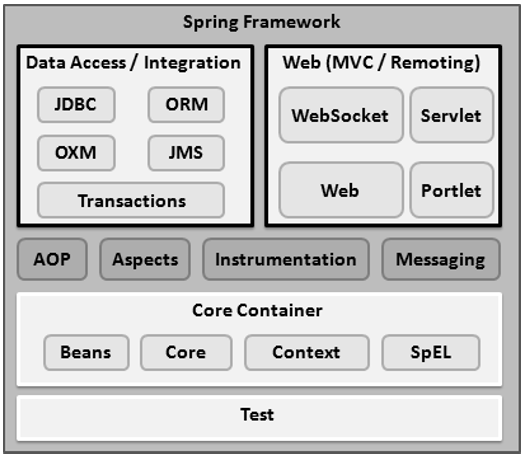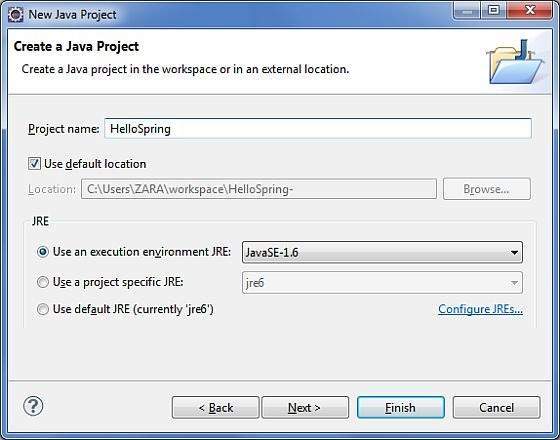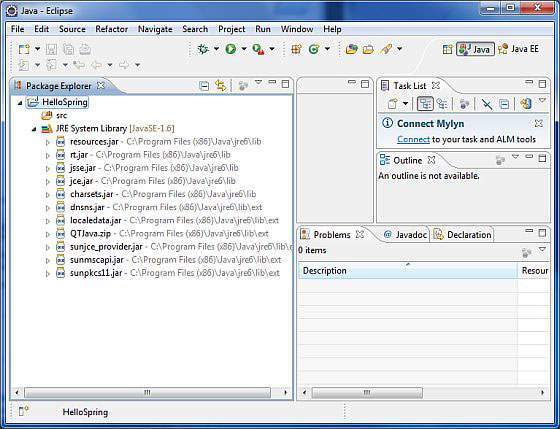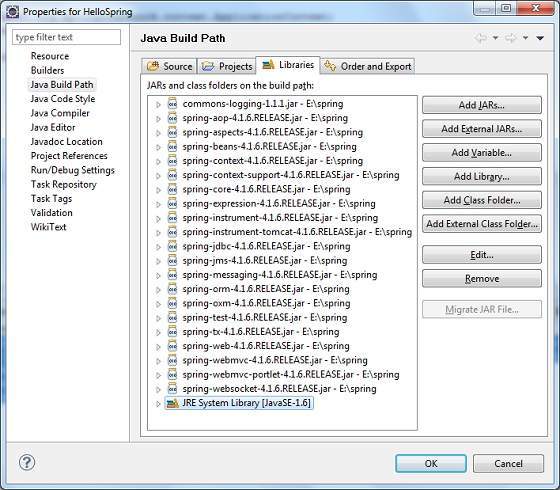Spring is the most popular application development framework for
enterprise Java. Millions of developers around the world use Spring
Framework to create high performing, easily testable, reusable code.
Spring framework is an open source Java platform and it was initially written by Rod Johnson and was first released under the Apache 2.0 license in June 2003.
Spring is lightweight when it comes to size and transparency. The basic version of spring framework is around 2MB.
The core features of the Spring Framework can be used in developing any Java application, but there are extensions for building web applications on top of the Java EE platform. Spring framework targets to make J2EE development easier to use and promote good programming practice by enabling a POJO-based programming model.
The Spring Framework provides about 20 modules which can be used based on an application requirement.

Following are the simple steps to download and install the framework on your machine.
 You will find all the Spring libraries in the directory E:\spring\libs.
Make sure you set your CLASSPATH variable on this directory properly
otherwise you will face problem while running your application.
You will find all the Spring libraries in the directory E:\spring\libs.
Make sure you set your CLASSPATH variable on this directory properly
otherwise you will face problem while running your application.
Once you are done with this last step, you are ready to proceed for your first Spring Example.
So let us proceed to write a simple Spring Application which will print "Hello World!" or any other message based on the configuration done in Spring Beans Configuration file.
 Once your project is created successfully, you will have following content in your Project Explorer:
Once your project is created successfully, you will have following content in your Project Explorer:


Spring framework is an open source Java platform and it was initially written by Rod Johnson and was first released under the Apache 2.0 license in June 2003.
Spring is lightweight when it comes to size and transparency. The basic version of spring framework is around 2MB.
The core features of the Spring Framework can be used in developing any Java application, but there are extensions for building web applications on top of the Java EE platform. Spring framework targets to make J2EE development easier to use and promote good programming practice by enabling a POJO-based programming model.
Benefits of Using Spring Framework:
Following is the list of few of the great benefits of using Spring Framework:- Spring enables developers to develop enterprise-class applications using POJOs. The benefit of using only POJOs is that you do not need an EJB container product such as an application server but you have the option of using only a robust servlet container such as Tomcat or some commercial product.
- Spring is organized in a modular fashion. Even though the number of packages and classes are substantial, you have to worry only about ones you need and ignore the rest.
- Spring does not reinvent the wheel instead, it truly makes use of some of the existing technologies like several ORM frameworks, logging frameworks, JEE, Quartz and JDK timers, other view technologies.
- Testing an application written with Spring is simple because environment-dependent code is moved into this framework. Furthermore, by using JavaBean-style POJOs, it becomes easier to use dependency injection for injecting test data.
- Spring's web framework is a well-designed web MVC framework, which provides a great alternative to web frameworks such as Struts or other over engineered or less popular web frameworks.
- Spring provides a convenient API to translate technology-specific exceptions (thrown by JDBC, Hibernate, or JDO, for example) into consistent, unchecked exceptions.
- Lightweight IoC containers tend to be lightweight, especially when compared to EJB containers, for example. This is beneficial for developing and deploying applications on computers with limited memory and CPU resources.
- Spring provides a consistent transaction management interface that can scale down to a local transaction (using a single database, for example) and scale up to global transactions (using JTA, for example).
Spring Framework Architecture
Spring could potentially be a one-stop shop for all your enterprise applications, however, Spring is modular, allowing you to pick and choose which modules are applicable to you, without having to bring in the rest. Following section gives detail about all the modules available in Spring Framework.The Spring Framework provides about 20 modules which can be used based on an application requirement.

Core Container:
The Core Container consists of the Core, Beans, Context, and Expression Language modules whose detail is as follows:- The Core module provides the fundamental parts of the framework, including the IoC and Dependency Injection features.
- The Bean module provides BeanFactory which is a sophisticated implementation of the factory pattern.
- The Context module builds on the solid base provided by the Core and Beans modules and it is a medium to access any objects defined and configured. The ApplicationContext interface is the focal point of the Context module.
- The SpEL module provides a powerful expression language for querying and manipulating an object graph at runtime.
Data Access/Integration:
The Data Access/Integration layer consists of the JDBC, ORM, OXM, JMS and Transaction modules whose detail is as follows:- The JDBC module provides a JDBC-abstraction layer that removes the need to do tedious JDBC related coding.
- The ORM module provides integration layers for popular object-relational mapping APIs, including JPA, JDO, Hibernate, and iBatis.
- The OXM module provides an abstraction layer that supports Object/XML mapping implementations for JAXB, Castor, XMLBeans, JiBX and XStream.
- The Java Messaging Service JMS module contains features for producing and consuming messages.
- The Transaction module supports programmatic and declarative transaction management for classes that implement special interfaces and for all your POJOs.
Web:
The Web layer consists of the Web, Web-MVC, Web-Socket, and Web-Portlet modules whose detail is as follows:- The Web module provides basic web-oriented integration features such as multipart file-upload functionality and the initialization of the IoC container using servlet listeners and a web-oriented application context.
- The Web-MVC module contains Spring's model-view-controller (MVC) implementation for web applications.
- The Web-Socket module provides support for WebSocket-based, two-way communication between client and server in web applications.
- The Web-Portlet module provides the MVC implementation to be used in a portlet environment and mirrors the functionality of Web-Servlet module.
Miscellaneous:
There are few other important modules like AOP, Aspects, Instrumentation, Web and Test modules whose detail is as follows:- The AOP module provides aspect-oriented programming implementation allowing you to define method-interceptors and pointcuts to cleanly decouple code that implements functionality that should be separated.
- The Aspects module provides integration with AspectJ which is again a powerful and mature aspect oriented programming (AOP) framework.
- The Instrumentation module provides class instrumentation support and class loader implementations to be used in certain application servers.
- The Messaging module provides support for STOMP as the WebSocket sub-protocol to use in applications. It also supports an annotation programming model for routing and processing STOMP messages from WebSocket clients.
- The Test module supports the testing of Spring components with JUnit or TestNG frameworks.
Spring Environment Setup
I assume you already have setup for Java Development Kit (JDK) and Eclipse IDE. So now let us see how to setup Spring Framework libraries:Following are the simple steps to download and install the framework on your machine.
- Make a choice whether you want to install Spring on Windows, or Unix and then proceed to the next step to download .zip file for windows and .tz file for Unix.
- Download the latest version of Spring framework binaries from http://repo.spring.io/release/org/springframework/spring.
- At the time of writing this tutorial, I downloaded spring-framework-4.1.6.RELEASE-dist.zip and when you unzip the downloaded file it will give you directory structure inside E:\spring as follows.
 You will find all the Spring libraries in the directory E:\spring\libs.
Make sure you set your CLASSPATH variable on this directory properly
otherwise you will face problem while running your application.
You will find all the Spring libraries in the directory E:\spring\libs.
Make sure you set your CLASSPATH variable on this directory properly
otherwise you will face problem while running your application.Once you are done with this last step, you are ready to proceed for your first Spring Example.
Spring Hello World Example
Let us start actual programming with Spring Framework. Before you start writing your first example using Spring framework, you have make sure that you have setup your Spring environment properly as explained in Spring - Environment Setup tutorial. I also assume that you have a little bit working knowledge with Eclipse IDE.So let us proceed to write a simple Spring Application which will print "Hello World!" or any other message based on the configuration done in Spring Beans Configuration file.
Step 1 - Create Java Project:
The first step is to create a simple Java Project using Eclipse IDE. Follow the option File -> New -> Project and finally select Java Project wizard from the wizard list. Now name your project as HelloSpring using the wizard window as follows: Once your project is created successfully, you will have following content in your Project Explorer:
Once your project is created successfully, you will have following content in your Project Explorer:
Step 2 - Add Required Libraries:
As a second step let us add Spring Framework and common logging API libraries in our project. To do this, right click on your project name HelloSpring and then follow the following option available in context menu: Build Path -> Configure Build Path to display the Java Build Path window as follows:

No comments:
Post a Comment